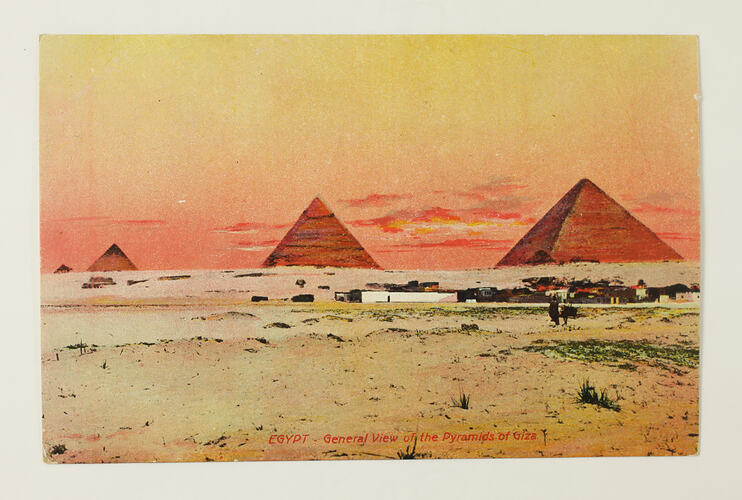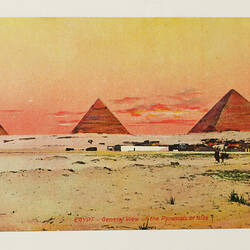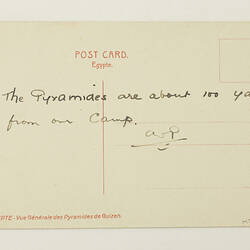Summary
Postcard featuring a colourised image of the three main pyramids at Giza. From a World War I album from Egypt containing 33 postcards, most featuring Egyptian themes. Of particular interest amongst these postcards is one containing a letter written to 'Father' (presumably John Peile Snr) signed by 'VS' that mentions Albert Peile. The inclusion of this postcard suggests that the album either belonged to or was compiled by John Peile Snr or another member of the Peile family.
Part of a collection of material relating to the World War I service of brothers John and Albert Victor Peile, who both died in the conflict. Younger brother Albert enlisted first. He was a 22-year-old unmarried clerk when he enlisted on 27 August 1914, service number 769, 3rd Battalion. He served in Gallipoli and later France, and was eventually promoted to the rank of corporal. He died in Bullecourt, France on 4 May 1917 and his body was never found. He is commemorated at the Villers-Bretonneux Memorial. His brother John Peile was a 38-year-old unmarried miner when he enlisted on 25 June 1915, service number 2662, 2nd Battalion. He also served in in Gallipoli and France, and was similarly promoted to corporal. He died in France on 18 September 1918 and is buried at Roisel Communal Cemetery Extension, France. Their mother died only a few years later in 1926, aged 73.
Their niece was Mrs M. J. Hitchens, the donor. Margaret Joan Hitchens (1916-?) was the daughter of Albert and John's sister Alice and her husband John Henry Dinwoodie.
The pyramids at Giza were built during the Egyptian Old Kingdom for three kings of the Fourth Dynasty (c. 2613-2494 BC): Khufu, Khafre and Menkaure. Despite not being the oldest pyramids in Egypt, these three are the most famous. Although only the three pyramids are shown here, all three were part of a complex of buildings comprising a mortuary temple, causeway, valley temple and subsidiary temples. Recent finds within the Giza necropolis have also unearthed the township of the pyramid workers.
Description of Content
Two pyramids in sunset or sunrise landscape.
Physical Description
Crudely colourised image of three pyramids, the colour of the sky suggests that the image was taken at either sunset or sunrise. What looks to be a small town or village is depicted towards the middle of the image and off to the right. Both the village and the pyramids are surrounded by desert.
More Information
-
Collection Names
Military Memorabilia Collection, Returned and Services League (RSL) Collection
-
Collecting Areas
-
Acquisition Information
Donation from Victorian Branch, Returned & Services League of Australia Limited (RSL), Mrs Margaret J. Hitchens, 1986
-
Place & Date Depicted
-
Format
Album
-
Inscriptions
Printed in red ink on the front of the postcard: 'EGYPT - General View of the Pyramids of Giza' Hand-written in black ink on the back of the postcard: 'The Pyramides are about 100 yards / from our camp. / (illeg.)' Printed on the back of the postcard: 'POST CARD / Egypte' Printed on the back of the postcard in the bottom left corner: 'EGYPTE - Vue Generale des Pyramides de Guizeh'
-
Classification
-
Category
-
Discipline
-
Type of item
-
overall dimensions
138 mm (Width), 89 mm (Height)
-
References
Lorna Oaks, Sacred Sites of Ancient Egypt: An Illustrated Guide to the Temples and Tombs of the Pharaohs, Hermes House (London, 2003); p. 53-4 'Memphis and it's Necropolis - the Pyramid Fields from Giza to Dashur,' UNESCO World Heritage Centre, at: [Link 1] accessed: August 6, 2012 For Albert Peile's war record see the National Archives of Australia website at: [Link 2] For John Peile's war record see the National Archive of Australia website at: [Link 3]
-
Keywords
World War I, 1914-1918, Pyramids, Egyptian Archaeology, Postcards


